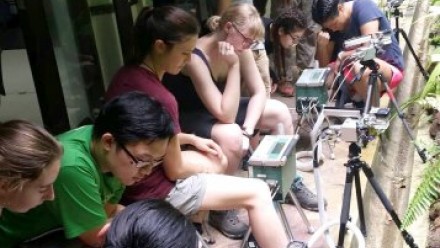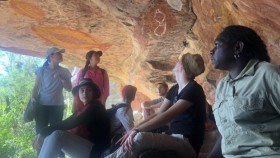Alexandra Catling - Travel Journal: Singapore and Malaysia
by Alexandra Catling, 2018 Honours student
Alexandra Catling indulges in her passion for scientific research on a trip to south east Asian forests. And discovers leeches.
I’m studying an Advanced Science degree, majoring in biology with a minor in plant science, so the field trip was a terrific opportunity.
Last year I went to the Daintree Rainforest for the Field Studies in Functional Ecology course and this year, my Honours year, I was able to go on the course again – this time to Singapore and Malaysia, as a tutor with third-year students.
The entire course is run in two weeks – it’s the equivalent of a semester course – so it’s extremely intensive and people work really hard. It was fantastic for me to go as a staff member and have the chance to learn so much about tropical forest research.
For my honours research project, I’m looking at how temperature affects plants. It is important that we understand exactly how plants are likely to respond to changes in the environment at a fine scale, so I am looking at how a wide range of growth temperatures can affect thermal tolerance and other traits.
In Singapore we visited the island of Pulau Ubin where we had the freedom to investigate the native plants and animals and pose questions and test hypotheses about the ecosystems we encountered.
We also conducted research in the Bukit Timah Nature Reserve, a conservation area in the middle of the country, which contains both primary rainforest, that remains undisturbed by human activity, and secondary rainforest where regeneration is taking place.
We were lucky to have Professor Owen Atkin from the ANU Division of Plant Sciences to demonstrate equipment to measure photosynthesis and respiration on different plant samples.
What you do is clamp a leaf into the chamber of the Li-Cor 6400 which measures gas influx and efflux and from that you can determine how much the sample is photosynthesising or respiring. It’s a really handy tool to use in the field.
We were looking at how rates of photosynthesis and respiration relate to the growth rate and success of different species in primary and secondary rainforests, which tend to differ greatly in light availability.
An important part of this course was building collaboration between ANU and Nanyang Technological University (NTU) in Singapore. There were three NTU students and 15 from ANU. We lived on the NTU campus for about a week and it was great to see what it’s like to be a student at another university.
The third-year students are marked on the research projects they do on this course. They have to write up their projects and present their findings. At the start, some of the students weren’t comfortable with public speaking and were relying heavily on notes, but throughout the course their confidence grew and it was fantastic to see their improvement by the end.
In Malaysia we stayed in the Endau-Rompin National Park, a protected tropical rainforest.
Driving there, you see seemingly endless palm oil plantations which was conflicting for me. I was expecting the plantations to be devastated and was surprised to find that they were beautiful in a unique way. It was eye-opening to learn more about the economic drivers of these plantations up close and understand how many people rely on these plantations for their livelihood.
We spent a whole day walking up Gunung Janing Barat and sampling as we went. At the top of the mountain there are an extraordinary number of big fan palm trees, a species which cannot be found anywhere else in the world. We also found carnivorous pitcher plants and elephant tracks at the base of the mountain.
We travelled along the river in boats, however the water level was extremely low so our boat got stuck at one point and a couple of students had to jump out and help push us along.
In the same river, we saw giant lizards mating – monitor lizards – which I at first thought were crocodiles.
I think for many people on our trip, Malaysia was a major highlight. We were there for only four days and were in the middle of nowhere, without Internet or hot water, but experiences like these build lasting friendships and are invaluable for getting in touch with nature and learning.
We learnt so much that you can really only learn on field trips like this.
Another day we were all walking along a road, sampling Syzgium leaves, when we decided to walk off the path to look for more of these trees.
I took two steps off the road and suddenly a giant stick insect was climbing up my thigh. I yelled a lot but, receiving no help, batted it off before continuing down the hill with my heart racing. Not long into our sampling, our small group looked down and noticed a sea of moving black things – leeches!
I grew up in Canberra and I’ve never had a leech on me. And I can happily say none had the chance to bite me in Malaysia. This was mostly because when we were walking in a line, you became responsible for watching the legs of the person in front of you to make sure they didn’t have leeches on them. This was a fun exercise in camaraderie as it meant we were all quite literally ‘watching one another’s back’.
I knew I was scared of bugs before this trip, but I didn’t realise how simultaneously terrifying and fascinating they could be until we went spotlighting at night and saw a remarkable diversity of creepy crawlies. If you shone your light on the ground, you would see green dots everywhere – they were spiders’ eyes, reflecting back at you – and there were hundreds of them.
On this part of the trip, we were totally out of our comfort zone but it was a brilliant and unforgettable experience.
- This article originally appeared in the ANU Reporter, Volume 49, number 4, Summer 2018.
- Field studies in Functional Ecology course information
- Advanced field studies in Functional Ecology course information
- Video : Field studies in functional ecology at Kosciuszko National Park (2016)
- Video: Field studies in functional ecology at Daintree Rainforest (2017)
- Video: Advanced field studies in functional ecology in Singapore and Malaysia (2018)










